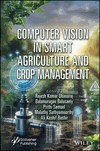Computer Vision-Based Innovations for Smart Agriculture and Crop Surveillance
Evolution, Trends, and Future Challenges
Summary
The economic prosperity of a nation relies heavily on its agricultural industry. Due to population expansion, frequent climate change, and material restriction, it has become harder to supply the food needs of the present population. Precision agriculture, also frequently referred to as smart agriculture, is a cutting-edge method for addressing the challenges associated with agricultural sustainability. This cutting-edge technology is powered by a system based on computer vision (CV) and artificial intelligence (AI). These AI and CV techniques have made remarkable contributions to the agricultural industry in the areas of plant health detection and monitoring, planting, weeding, harvesting, and modern weather forecast analysis. So many use cases of smart farming have an influence on the whole food supply chain by offering insightful data on the entire agricultural process, easing operational decision-making in real-time, and improving farming methods by adding smart sensors and equipment to the field. The use of CV in agriculture has recently increased. Computer vision has enormous potential to improve the whole functioning of the agricultural industry, from lowering production costs through intelligent automation to increasing output.
Artificial intelligence includes the field of CV. Because of breakthrough technology, machines can now understand and perceive the visual environment in a manner that is comparable to that of humans. Computer vision techniques combined with image capturing from remote cameras provide agriculture-specific, non-contact, and scalable sensing solutions. The CV–AI models have made several contributions to the agricultural business in areas including harvesting, enhanced weather analysis, weeding, planting, and plant health detection and monitoring. This chapter covers the evolution, trends, and future challenges of smart farming using CV.



